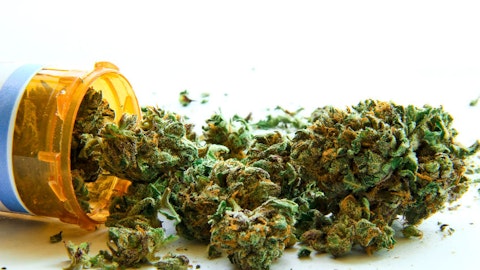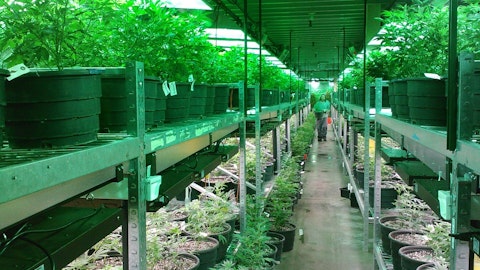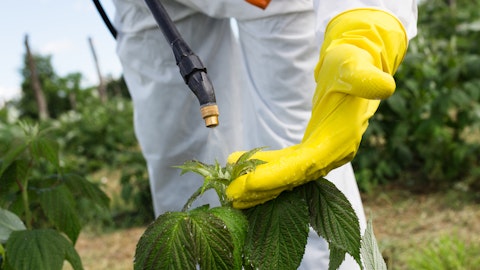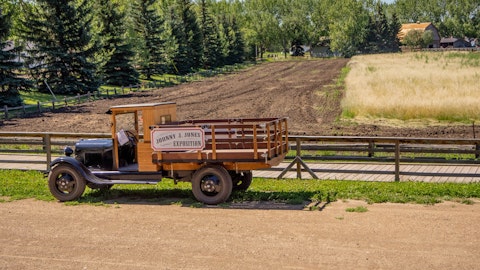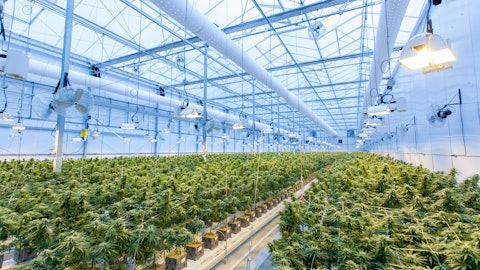Mandesh Dosanjh: Yes, maybe I’ll take it in a bit of a reverse order there, Aaron. So your second part was around Fraser Valley. We launched Fraser Valley last year to compete in the value space of flowers, an emerging space where as Pure Sunfarms, was carving out a really solid niche and continues to and everyday premium. We felt like we were under index or not represented while in value and Fraser Valley did that. And it’s taking a leading market share position one, two, three, in every market that it competes in, with a very, very limited assortment being led by Donnie Berger a strain that’s wildly popular across the country. So in that brand, we think there’s still a lot of opportunity, we see that segment, growing as we thought it would, as inflationary pressures with consumers.
And then tough economic times happen across the country. So we love Fraser Valley, it’s doing extremely well. It’s growing a significant amount of market share for us. And we think the ability to continue to leverage and play in Fraser Valley and take more profitable market share is definitely part of our strategy this year, and with some more innovative, exciting things happening within Fraser Valley. Dovetailing that into the first part of your question, which was, will it allow us to be a source for extra inventory or inventory where we might have gotten our supply chain and forecasting incorrect and be long on some inventory? Absolutely. Fraser Valley, is meant to be a value based SKU, it gives us gives consumers great affordability and great offerings and will definitely leverage it.
So it is an outlet for us on inventory that we’re long on. And then yes, Aaron, I think you’re absolutely right. I mean, people are selling and being desperate out there. And we see kinds of spot prices in the b2b market all over the board. And it’s just not sustainable. We have a good bevy of customers that we deal with on the domestic b2b side. And it’s actually it’s allowed us to simplify, customers who want to buy consistent product that’s available that’s consistently grow with great quality. I mean, they’re coming to us. And that’s what we like dealing with. So we do see a lot of kind of irregularity on the spot market. And its kind of feast or famine, we see a lot of inbound calls come as pricing or things dry out there. And I just don’t think it’s sustainable.
And then people are going to be desperate. I’m not sure, Mike, if you want to add any more color on the desperation of other producers or what’s happening there.
Michael DeGiglio: Yes, well, I mean, we’re really focused on the retail side and you can see it in the numbers 25% year-over-year, as we mentioned in the call. But yes, as Mandy said, we you know, it’s not sustainable. It’s just not durable long term. We have a real solid handle on our costs and think we know pretty well what the cost of production is by many other LPs and the prices that are selling for, it’s just not sustainable. Now, it may last all €˜23 may even go into €˜24. It’s hard to really say. But it is a perishable product at some point, the value just diminishes, and we’ll be patient. So, that’s the color on that. Thanks.
Aaron Grey: Great. Thanks for the color. I’ll get back in the queue.
Operator: Thank you. Our next question will come from Frederico Gomes of ATB Capital Markets, your line is open.
Frederico Gomes : Good morning. Thanks for taking my questions. My first question is on the divestment of your facility in Texas. How long do you think that that sales process will take and how much do you expect to sell it for, any color on that front? Thank you.
Michael DeGiglio: Yes, we’re not going to comment on what we expect today for that asset, we don’t think it’ll take too long, probably the process has started. So, probably four to six months is what I would guess. It’s a great asset. As I mentioned, on the call, where we are out, the majority of our Texas assets are in one location, which is just the most ideal location, we believe in the United States are one of the top three. And we have a large footprint there, it’s an expandable footprint. That’s where most of our management team is. The Permian Basin is sort of out there on its own. So we want to focus our whole team on that larger footprint. But, I think for Texas, when you really look at the ability to have an asset in Texas, as big as Texas, it is an asset like this, it’s very limited where those assets can be, so we think it’s a very valuable asset, and that we’re optimistic that the process will move fairly quickly, Frederico.
Frederico Gomes: Okay, thanks for the color. And then my other question is on the Canadian cannabis side, most of your exposure right now obviously remains in flower. But could you provide some more details on the initiatives that you have in place for other categories, I think especially pre rolls, do you expect any uptick in sales from that category, this year, any new products, investment and automation, et cetera? Can you talk about that?
Michael DeGiglio: Well, I’ll turn it over to Mandesh to add some color. But I will start by saying that we consider pre rolls really as part of raw flower as we classify internally, and it is a very — it’s a growing market for sure. And as we speak, we just made another huge investment, capital investment in pre rolls. So, we’re very focused on it, and we’re focused to win in that market. Mandy, some color on that?
Mandesh Dosanjh: Yes, thanks for the question. And appreciate the starting point there, Mike. And just to Mike’s point, yes, we did increase our capital expenditure to add additional pre roll capacity, and Frederico, I’ll talk about the pre roll. And then the other kind of derivative based products after. Pre was a huge part of our strategy. I mean, we see that conversion from the flower, whole flower, consumer wanting more convenience and pre rolls. And we’re absolutely continue looking at our assortment and launching new SKUs to match some of our new strain offerings that are in market and then expanding into new strains that aren’t in pre roll. So, big focus, not just in Pure Sunfarms, but also now with our Fraser Valley.
And then eventually, sorry — with our store cannabis premium line, and then coming down the road with our Fraser Valley. So, managing assortment in the pre-roll category, huge opportunity for us. And I think you’ll see more innovation there and we’re continually getting more listings. And then in a similar story on vapes. So in the process of doing, an interesting vape refresh on our main line and looking to expand that portfolio with great offerings. And then the infused pre-roll category, obviously, a category that’s definitely top of mind right now with consumers growing share in each of the key markets. And for us, it’s just about figuring out and doing a SKU the right way, the right profitable way where we can grow meaningful and sustainable market share.
And so we’re not always going to be the first ones there. But we’re going to do it the right way. So lots more to come. We’re just not resting on our laurels. As you know the number one flower company in Canada, it’s about looking at other opportunities, and it will be part of our 2023 beyond strategy.
Frederico Gomes: Thanks for that. I’ll back in the queue. Thank you.
Michael DeGiglio: Thanks, Frederico.
Operator: Our next question will come from Scott Fortune of ROTH MKM, your line is open.
Unidentified Analyst : Hey, good morning. This is Nick on for Scott. Good morning, guys. Wondering if you could just provide a little color on mix specifically within the flower category kind of between the premium mainstream and value segments. And just kind of how you expect that to evolve as some of these new product launches take hold? Thank you.
Michael DeGiglio: Mandesh?
Mandesh Dosanjh: Sorry, I was just on mute there. Thank you. Last year, when we launched Fraser Valley, we were really talking to this group, the analysts group and kind of in market of that real clear separation in value, core and premium. And we are starting to see a bit more of that shift into the value but the course still being there and premium being you know, 15% or so 20% of kind of the full flower offering. So, 15% to 20%, of any kind of category in premium, you see the bulk of those sales kind of 40% 50% in core, and then another 20% 30% in value. And so kind of that’s kind of how it shaking out in certain regions, whether it’s Alberta, British Columbia, Ontario might be slightly over under index. And now we’re squarely positioned with three great brands.
And each of those segments, so value being Fraser Valley, weed company, Pure Sunfarms playing in core and our store cannabis in Premium. And what we’re seeing our expectation for the year is growth in all three. And we’re not seeing cannibalization across that I think that’s a key piece. So as we saw with the launch of Fraser Valley and so we’re getting again, profitable, meaningful market share, without impacting our core Pure Sunfarms offering. So I think that’s the key for us as we took our time to launch these three brands, the two other brands that will exist alongside Pure Sunfarms. And we wanted to do in a meaningful way that had differentiation. And that grew market share. So we’re seeing that and the plan this year is to grow. And again, in the Premium market for Soar cannabis, I mean, it’s a much smaller market, the bulk of our growth rule will really come at Pure Sunfarms being the biggest brand.
And then Fraser Valley being the second biggest. So those will be the two main drivers on growth. But we’re excited what Soar has done and already been able to take kind of a 1% to 2% share of flower in the markets that it’s operating.
Unidentified Analyst : Got it. I appreciate that color. And then just a second for me on the international side. You mentioned solid growth in Australia, commencement of sales in Israel. Just wondering if you had any commentary on the newer markets. I know you’re one of the few in the Dutch market, and it looks like Spain looking to ramp capacity. Just any opportunities out there internationally that you’re kind of looking at or evaluating, just some color, that would be helpful? Thank you.
